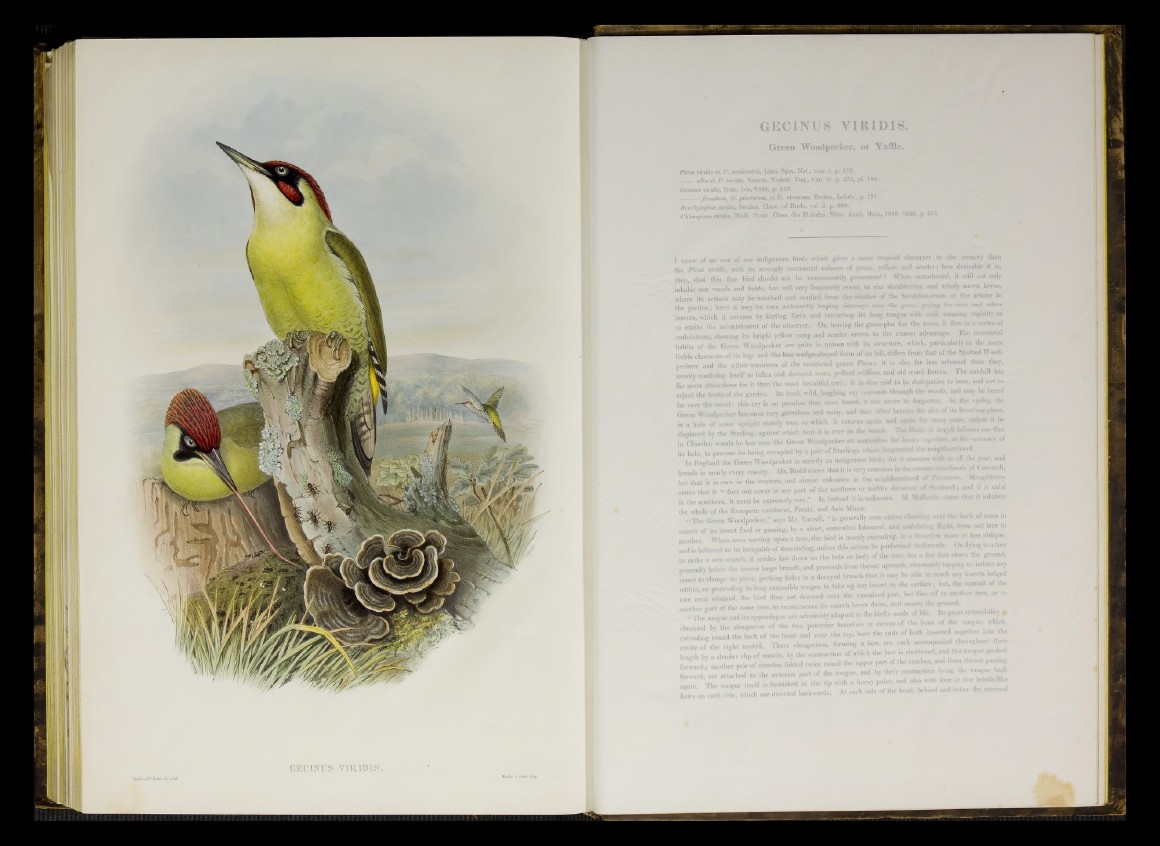
GEC1NUS VIRIDIS.
Green Woodpecker, or Yaffle.
Pieus viridis et P. semirostris, Linn. Syst. Nat., tom. i. p. 175.
—— alba et P. viridis, Nozem. Nederl. Vog., tom. iv. p. 373, pi. 190.
Gecinus viridis, Boie, Isis, '1828, p. 31.6.
Jrondium, G. pinetorum, et G.virescens, Brehm, Lehrb., p. 197.
Brachylophus viridis, Swains. Class, of Birds, vol. U. p. 308.
Chloropieus viridis, Math. Nouv. Class, des PicinSes, Mfim. Acad. Metz, 1848-1849, p 351.
I k n o w of no one of our indigenous birds which gives a more tropical character to the scenery than
the Pieus viridis, with its strongly contrasted colours of green, yellow, a©d scarlet ; how desirable it is,
then, tlmt this fine bird should not be unnecessarily persecute!1! '1 hen unmolested, it will not only
inhabit our woods and fields, but will very frequently resort to our shrubberies, and trimly mown lawns,
where its actions may be watched and studied from the window of the !:i I'jst-room or the arbour hi
the garden; here it may be seen awkwardly leaping sideways over the grass, prying for ants and other
insects, which it secures by darting forth and retracting its long tongue with such amazing rapidity as
to excite the astonishment of the observer. On leaving the grass-plat for the trees, it flies in a series of
undulations, showing its bright yellow rump and scarlet crown to the utmost advantage. The terrestrial
habits of the Green Woodpecker are quite in unison with its structure, which, particularly in the more
feeble character of its legs and the less wedge-shaped form of its bill, differs from that of the Spotted Woodpeckers
and the other members of the restricted genns P ia u ; it is also far less arboreal than they,
mostly confining itself to fallen and decayed trees, pollard willows, and old wood fences. The ant-hdl has
far more attractions for it than the most bcautifid tree ; it is also said to be destructive to bees, and not to
reject the fruits of the garden. Its loud, wild, laughing cry sounds through the woods, and may be heard
far over the mead: this cry is so peculiar that, once heard, it can never be forgotten. In the spring the
Green Woodpecker becomes very garrulous and noisy, and thus often betray- the site of its breediug-place,
in a hole of some upright stately tree, to which it returns again and again !. i many years, unless it be
displaced by the Starling, against which bird it is ever on die watch. The Dak* ,.i Argyll mform. me that
in Cliveden woods he has seen the Green Woodpecker sit motionless for hour, together, at the entrance of
its hole, to prevent its being occupied by a pair of Starlings which frequented the neighbourhood.
In England the Green Woodpecker is strictly an indigenous bird; for ft remains with us all the year, and
breeds in nearly every county. Mr. Rodd states that it is very common in the eastern woodlands of Cornwall,
hut that it is rare in the western, and almost unknown in the neighbourhood of Ehrnairee. Macgdhvray
states that it “ does not occur in any part of the northern or middle divisions of Hmdiuid; and if it exist
in the southern, it must be extremely rare.” In Ireland it is unknown. M. Matterhe states that it inhabits
the whole of the European continent, Persia, and Asia Minor.
.. The Green Woodpecker,” says Mr. Yarrell, “ is generally seen either climbing over the hark of tree. ...
search of its insect food or passing, by a short, somewhat laboured, and undulating flight, from one tree to
another. When seen moving upon a tree, the bird is mostly amending, in a direction more or less oblique,
and is believ'd to be incapable of deseeding, adless this action be performed backwards. On flying to a tree
to make a new search, it settles low down on the bole or body of the tree, but a few feet above the ground,
generally below the lowest large branch, and proceed, from thence upw ards, alternately lapping to induce any
insect to change it, „lace, peeking holes in a decayed branch that it may be able to roach any insects lodged
within, or protruding its long extensible tongue to take up an , insect on the surface ¡but, the summit of the
tree once attained, the bird does not descend over the examined part, but fl.es off to another tree, or to
another port of the same tree, to recommence it, searoh lower down, and nearer the ground
.. TheVongne and its appendages are admirably adapted to the bird's mode of I* . Its great extensibility *
obtained by the elongation of'.be two posterior branches or cor„m of the bone of the tongue, which
extending round the hack of the head and over the top, have the ends of both inserted together into the
cavity of the right nostril. These elongations, forming a bow, are each accompanied throughout t ie,
length by a slender slip of muscle, b , the contraction of which the how is shortened, and the tongue pushed
forward; another pair of muscles, folded twice round the upper par. of the trachea, and from thence pacing
forward, arc attached to the anterior part of the tongue, and by their contraction bring t e ^ ^
. . . - . . . . •si. „ nnmf nnfl also with tour or five bristie-lihe